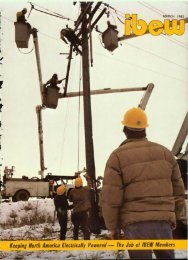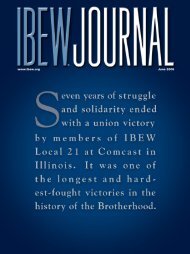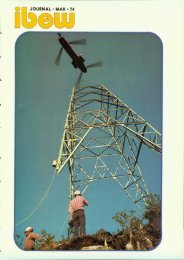t - International Brotherhood Of Electrical Workers
t - International Brotherhood Of Electrical Workers
t - International Brotherhood Of Electrical Workers
Create successful ePaper yourself
Turn your PDF publications into a flip-book with our unique Google optimized e-Paper software.
6 2<br />
WIhl,4 TAXES Paid<br />
qliCONSUMER CallRetont<br />
SIOME<br />
of the sweeping criticisms aimed<br />
at the electric power operations of<br />
the Tennessee Valley Authority are<br />
therlselves deserving of some critical examination.<br />
If the TVA activities constitute<br />
no sound basis for comparing the<br />
relative merits of private and public<br />
operation of power utilities, the pub ii<br />
should be so informed. On the other<br />
hand, the experiment is too important<br />
to permit it to be discredited by incomplete,<br />
mistaken or deliberately false<br />
information.<br />
The stakes are high. To appreciate how<br />
high, it is necessary only to reeall the<br />
long history of corporate interloehings<br />
and pyram lingo , tile finan.ci I metaphysics<br />
which characteri ze Iapr te utility<br />
operation. aid the consequent impotence<br />
of effective regulation which finally<br />
brought Cvnglrss to recognize that a<br />
yardstick of powerl opeettion1 is a desirable<br />
alnd ncessary thing. It is helpful<br />
to bear in mind that if the TVA can<br />
produce a sound and reliable standard<br />
LI power utility operations, then in addition<br />
to harness.ing the damaging flood<br />
waters of the Tennessee Valley, the<br />
project may succeed in stopping some of<br />
the equally damaging swollen streams<br />
of uniea :d utility profits.<br />
The issues most commonly raised relate<br />
either to the economic justfieatoion<br />
N;K''<br />
This fact<br />
throws light upon vexed TVA<br />
p)roblemss<br />
of the powel operations, or to, the questrin<br />
of taxation, or to a combmiarisn of<br />
both.<br />
MATIHEMATICAL EROSION<br />
One of the most superficially persuaive,<br />
and at the same time i.maginative.<br />
attacks on the TVA was one recently<br />
syndicated by thei (hicago Tribune Press<br />
Sevice. In challenging TVA's claim that<br />
its power operations had become self<br />
Siupporting up..n reaching an Intcomne of<br />
$15,000,000 annual.ly, this article quoted<br />
a statement that the dams, trnsmission<br />
lines, steam plants and other purchased<br />
aIs;ts had cost almost $30i5,000,000.<br />
Against this, it was asserteld, private<br />
utilities would have to pay 5 per cent<br />
as interest, and set up a depreciation reserve<br />
of 2.5 per cent, amountJng to over<br />
$22,000,000, plus taxes of $2,500,000 and<br />
operating expenses of $5,000,000, making<br />
a total of $30,000,000.<br />
Thus simply was the power operation<br />
if the TVA hrown for a $15,000.000<br />
annual loss! Thi; not very subtle reckonig.<br />
even if the figures .v el' acce pted,<br />
Z 0, I<br />
I T<br />
ITE ITTLE CONSUMER OF EIECTRICITY IN THE TVA REGION<br />
The JounlaI<br />
oe ELECTRICAL WORKERS and Operators<br />
makes he initial mistake of charging<br />
against power operations the entire cost<br />
of navigation improvement. flood-ontrol.<br />
LiOnioi in of national defense, fertilizer<br />
experimentation. etc. Consistency would<br />
require that, to tle TVA power rev-<br />
-fue there be added the many hundred,<br />
of millions of dollars resultng from proteelion<br />
agiehist flood loss, transportation<br />
perils, oil erosion and other tangible<br />
losses, to say nothing of the inreas.ed<br />
sccurity to life and happiness.<br />
DIVID)ENDS WITHOUT<br />
INVESTMENTS<br />
The article also makes the mistake of<br />
assuming that interest on the investment<br />
is properly chargeable to the expense of<br />
operat.ion., instead of r'eognizing it as<br />
a part of profits. The justification of<br />
stockholders' profits delends upon their<br />
furnishing the funds needed for a given<br />
enterprise. If the funds are nevertheless<br />
borrowed, the eF'eet of such borrowing<br />
shouli be to reduce the amounts available<br />
for dividends and not to increase<br />
consumer costs. Admission of any other<br />
theory would furnish ihe utility with a<br />
nmotive for remaining in debt perpetually<br />
so that dividemlns could be collected<br />
on an investment which is also supported<br />
by interest payments.<br />
But eve, if it were otherwise, it i'<br />
interesting to note that the bonds sold<br />
by the municipalities and cooperatives<br />
which buy TVA power secured by power<br />
revenue and not by taxation--were readlfly<br />
marketed at interest rates ranging<br />
fron onily 2.3 to 3.6 per cent instead of<br />
5 per cent used in the above computa-<br />
tion. With respect to depreciation, the<br />
let inconme of the TVA power operations<br />
was d!temiled only after deducting an<br />
average depreciation of 2.1 per cent.<br />
whereas the average, depreciation rate<br />
of 1 5fli private utility companies as reported<br />
to the Securities and Exchange<br />
(on is4h)o i was only 1.66 per cet in*<br />
stead of the 2.5 per cent which it was<br />
stated the utilities apply. The correction<br />
of interest and depreciation rates alone<br />
would he equivalent to a saving of about<br />
$11.000.001, even on the basis of the<br />
foregsing figures.<br />
SMOkE SCREEN<br />
Before considering tile question of taxation.<br />
it should he notedl that the TVA,.<br />
on its presenIt basis. will save consimers<br />
of electricity ill tile area which it serves<br />
approxinm ately $8.000,000 annually. In<br />
1933, before TVA. residential eonsu llers<br />
of the T allessee Electric Power Conpany<br />
paid an average of 5.77 cents per kilowatthour.<br />
in 19g3 the TVA average paid was<br />
109 cents per kilo itt-hour, as against<br />
a inatilnal average of 421 cents. These<br />
figures suggest that the -eal value of the<br />
taxato I.i ssue l.is in its eapacity to di<br />
vit attentilon fromn mote fundami..ental<br />
matters.<br />
Plobabty the niost noteworthy piresnitilfn<br />
of the tax issue was that which<br />
"'ppeared in full-page newspaper tldvel'tise<br />
mits of the Conommonwealth & S lbv-<br />
Crs (CenIpuny promptly after the transfer<br />
Continued oil poge 1C )

















